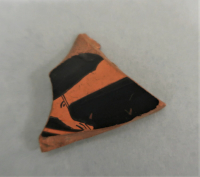


amphora
An item at Louvre
Decoration: on collar (side A); palmette and lotus flower (chain) on collar (side B); ivy leaf (file, 2) on shoulder; tongues on belly (side A); amazonomachy; hoplite (headband, helmet, chiton, short, baldric, scabbard, greaves, holding, shield, episema: tripod, half-kneeling, between); amazon (2, cap, chiton, short, himation, brandishing, spear, holding, reins, on); horse (2, harness, above); young man (2, chiton, short, 1, naked, 1, half-reclining) on belly (side B); comos scene; man (5, remains, 4, beard, 1, naked, 4, gesticulating) under handle; plant motif (remains, lotus flower, 5, pointed) on belly (below); lotus flower and bud (frieze); radiating edges Condition of the work: incomplete; gaps (under the handle BA, on the belly face B); breaks; numerous chips (mouthpiece, handles); reglued; completed; repainted
Department of Greek, Etruscan and Roman Antiquities
An exhibit at Louvre
The Department of Greek, Etruscan, and Roman Antiquities is home to a collection of artworks representing the Greek, Etruscan, and Roman civilizations; it illustrates the art of a vast area encompassing Greece, Italy, and the whole of the Mediterranean basin, and spans the period from Neolithic times (4th millennium BC) to the 6th century AD.




